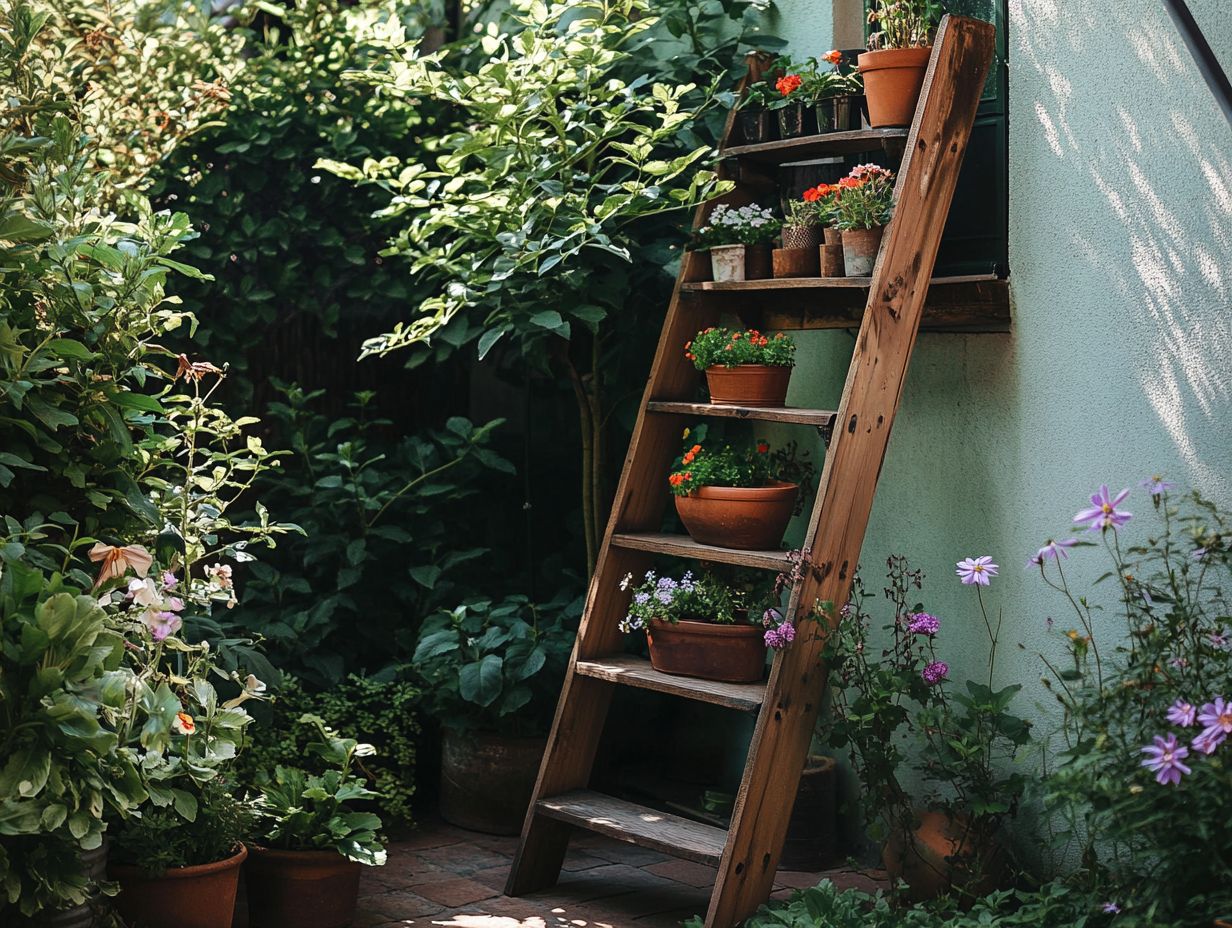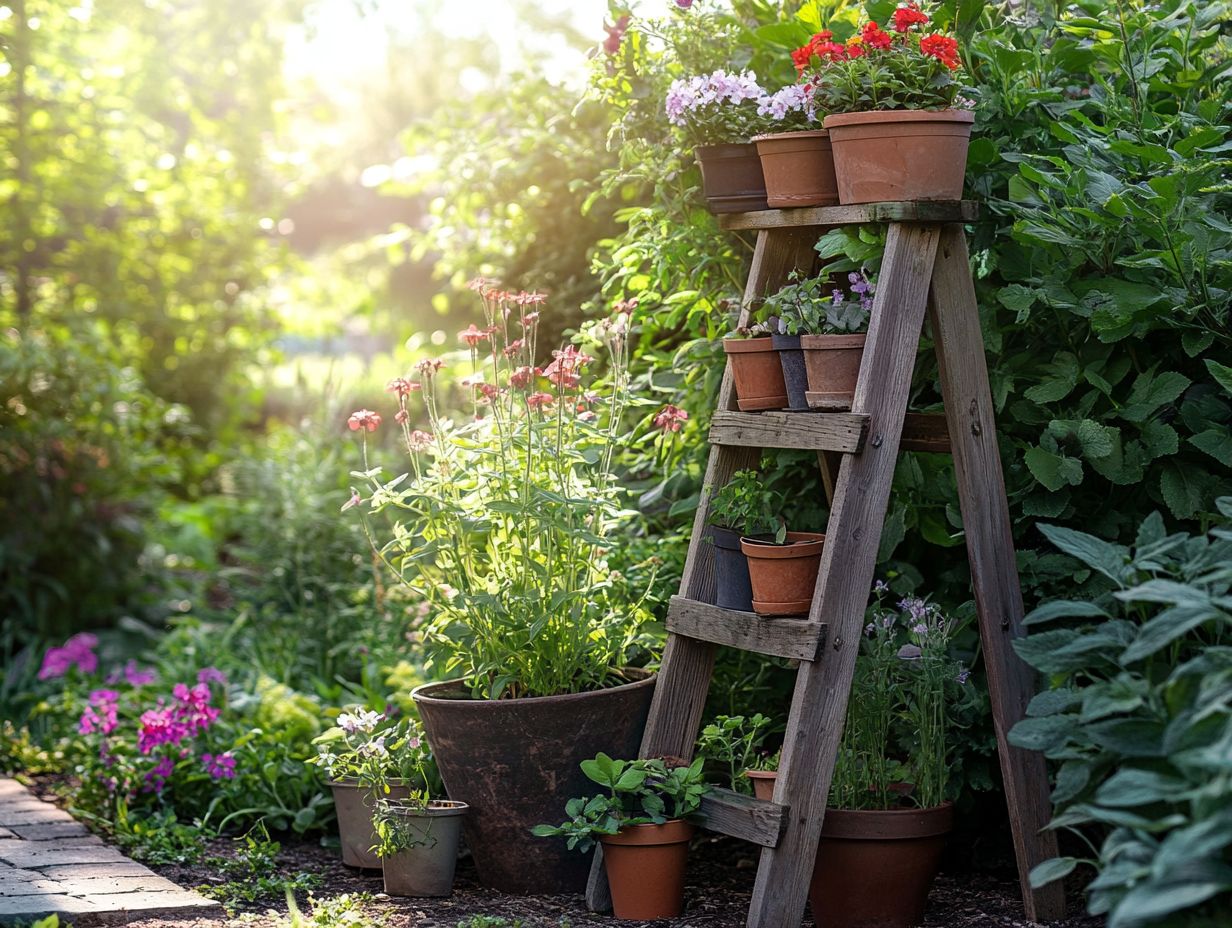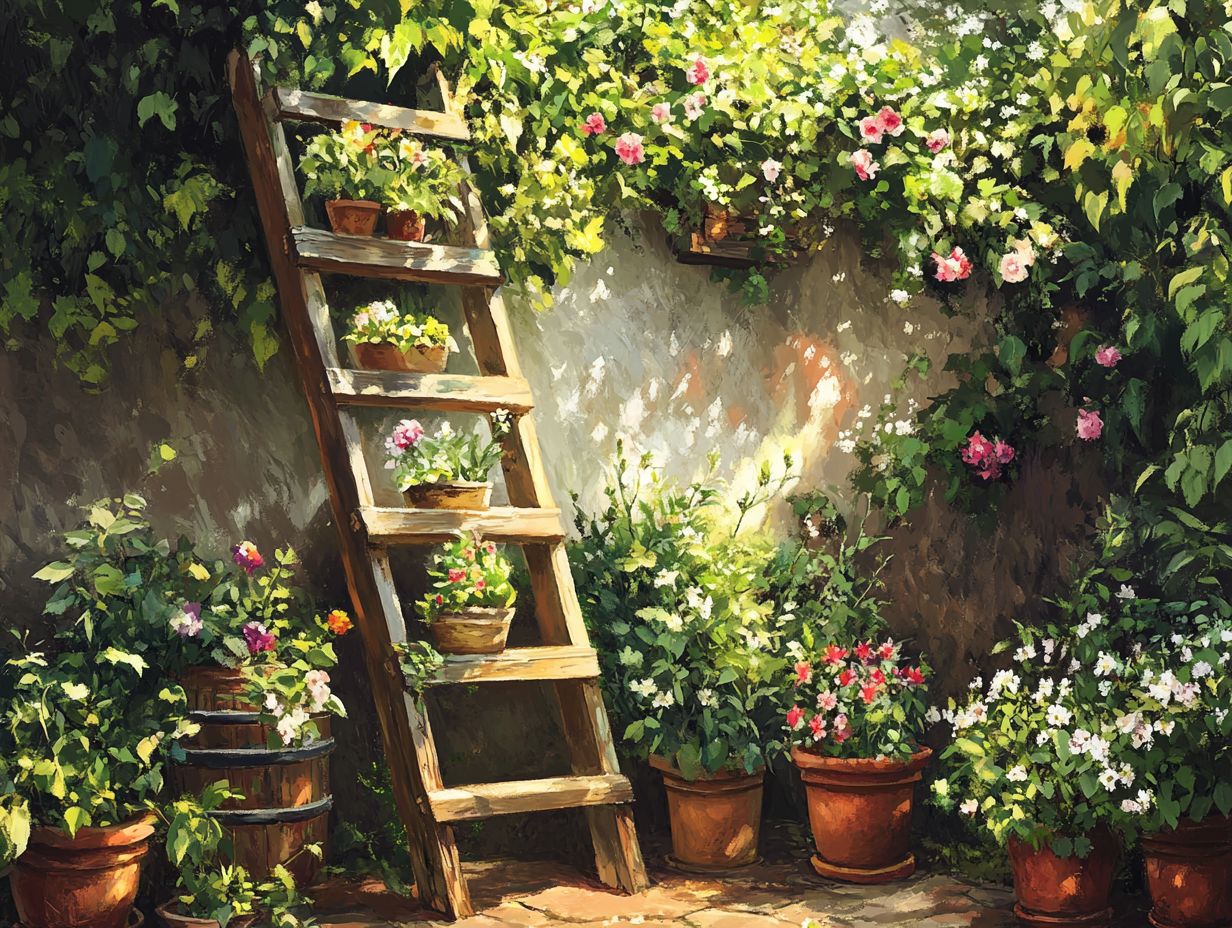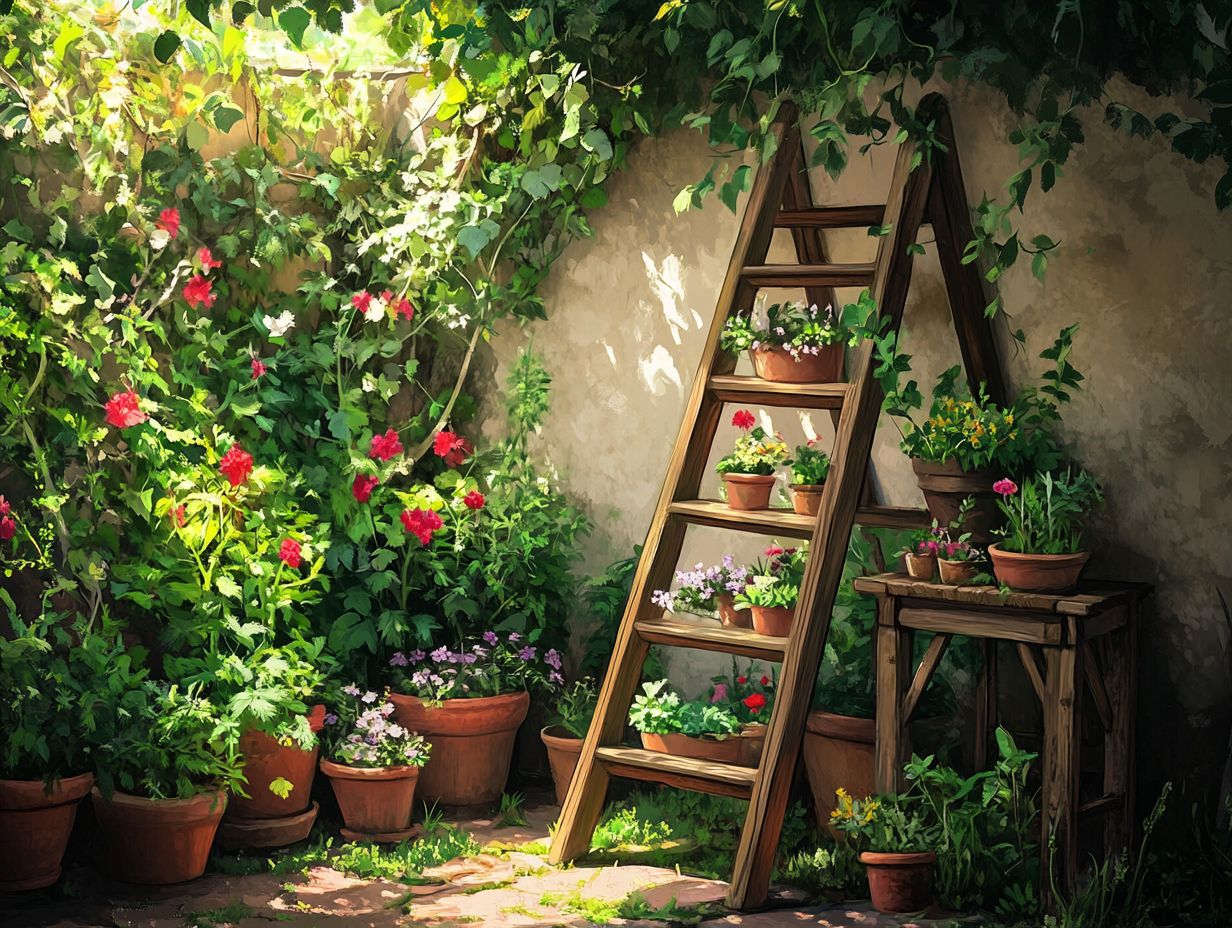Looking to maximize your gardening space while adding a unique touch to your outdoor area? Vertical planting might be just what you need.
This guide delves into the creative use of ladders as a vertical gardening solution, covering essential factors like choosing the right ladder for stability and height, as well as effective planting techniques.
You’ll also find tips on maintaining your vertical garden and discover creative ideas to elevate your gardening experience beyond simple planting. Get ready to take your gardening to new heights!
Benefits of Vertical Planting

Vertical planting represents an innovative technique in gardening that optimizes space utilization in both urban and traditional environments while fostering plant diversity and enhancing the visual appeal of gardens. This method involves the use of vertical structures, such as trellises, ladders, and planter boxes, to support climbing plants and create a visually striking display. By employing vertical gardening practices, individuals can effectively maximize limited outdoor spaces, making this technique particularly appealing to home gardeners and urban gardening enthusiasts.
Vertical planting contributes to improved soil management, water management, and sunlight exposure for plants, ultimately promoting healthier growth and better overall plant care. This approach encourages biodiversity by providing a conducive habitat for beneficial insects and pollinators. By strategically arranging plants, gardeners can create layers that not only enhance the health of climbing varieties but also elevate the aesthetic appeal of the garden.
Utilizing high-quality gardening supplies, including moisture-retentive soils and organic fertilizers, ensures that each plant flourishes in its vertical environment. For novice gardeners, vertical planting presents a wealth of opportunities, rendering gardening more accessible and manageable. Ultimately, this sustainable practice minimizes environmental impact, facilitating an eco-friendly lifestyle that benefits both the gardener and the surrounding ecosystem.
Choosing the Right Ladder for Vertical Planting
Selecting the appropriate ladder for vertical planting is essential to ensure safety, stability, and ease of access when managing a vertical garden, particularly when working with climbing plants or installing trellises and planter boxes.
A properly chosen ladder not only improves the gardening experience by providing a reliable platform for elevated planting but also serves as an aesthetically pleasing element in outdoor decor.
It is crucial to evaluate factors such as ladder height, material, and weight capacity, while also adhering to ergonomic gardening principles to maximize comfort and safety during use.
Considerations for Stability and Height
When selecting a ladder for vertical planting, two critical considerations are stability and height, both of which are essential for ensuring safe and effective gardening practices. A stable ladder not only prevents accidents but also facilitates easy access to elevated plants, thereby promoting effective gardening techniques and proper plant care.
Understanding the height requirements based on your garden design will assist in selecting the appropriate ladder that not only meets your vertical planting needs but also enhances your overall gardening experience.
The types of climbing plants being cultivated can significantly influence the required height of the ladder for effective care. For instance, when working with climbers that reach considerable heights, a ladder with greater reach may become necessary.
It is also important to consider your gardening space and the techniques employed, whether utilizing trellises, arbors, or wall-mounted planters. Ensuring that the ladder is positioned on stable ground and inspecting it for any signs of wear and tear can greatly enhance safety while working at elevated heights.
Incorporating practices such as regularly checking the ladder’s rungs and utilizing stabilizers contributes to a safer gardening experience while maximizing the effective use of vertical space.
Preparing Your Ladder for Planting

Preparing a ladder for use in a vertical garden requires several important steps to ensure safety and efficiency while employing effective planting techniques. Proper preparation enhances ladder stability and promotes ergonomic gardening practices, thereby reducing strain during planting and maintenance activities.
It is essential to ensure that the ladder is clean, stable, and positioned on level ground. Additionally, verifying its weight capacity is crucial to adequately support gardening tools and supplies while working on vertical structures.
Ensuring Safety and Proper Set-Up
Ensuring the safety and proper setup of your ladder is essential when engaging in vertical gardening, as it significantly mitigates the risk of accidents during plant arrangements and maintenance. Proper setup entails the use of ladder stabilizers, positioning the ladder on level ground, and ensuring that gardening tools are within reach to minimize unnecessary movements.
Adhering to these safety protocols allows for a focus on effective gardening techniques and the nurturing of climbing plants without undue concern.
It is advisable to inspect the ladder for any signs of wear and tear prior to use, as this can prevent unexpected failures. When positioning the ladder, one should take into account the height of the vertical garden and ensure there is adequate space for comfortable movement without the need for overreaching.
Always maintain three points of contact while climbing, and if gardening supplies are spread out, keep them organized in a nearby container to streamline workflow.
Implementing these outdoor gardening practices can significantly enhance not only efficiency but also the enjoyment of cultivating a vertical garden, ensuring that the experience is both safe and productive.
Planting Techniques for Vertical Ladders
Implementing effective planting techniques for vertical ladders is essential for ensuring the success of a vertical garden, particularly when working with climbing plants that require adequate support for optimal growth.
Utilizing various plant support methods, such as trellises and wires, can significantly enhance plant health and promote vertical growth, thereby maximizing the use of limited space in urban gardening or container gardening setups.
A thorough understanding of how to strategically space plants and train them to grow efficiently will result in impressive outcomes in garden design.
Best Plants for Vertical Growth

Selecting suitable plants for vertical growth is a crucial component of vertical gardening, as certain climbing plants thrive when supported by vertical structures such as ladders and trellises. Popular choices include various species of beans, peas, and flowering vines, which not only enhance the aesthetics of the garden but also contribute to biodiversity. Incorporating these plant types into a vertical garden can optimize space while elevating the overall design, making it an appealing option for gardening enthusiasts.
To maximize the effectiveness of vertical gardening endeavors, it is essential to choose plants with strong climbing capabilities. Ideal candidates often feature tendrils or twining stems, enabling them to ascend effortlessly and create a lush vertical display.
For instance, varieties such as sweet peas and morning glories are not only visually appealing but also require minimal maintenance, thriving in well-drained soil with sufficient sunlight. Additionally, plants like cucumbers and certain types of squash can be trained to grow upright, benefiting from the use of gardening supports such as sturdy trellises or netting.
With the appropriate selection of plants, vertical gardens can thrive, providing both functional space and visual interest.
Proper Spacing and Support
Proper spacing and support are fundamental elements in the design of a successful vertical garden, particularly when incorporating climbing plants that necessitate sufficient room for growth and development. Adequately spaced plants not only promote healthy growth but also enhance air circulation and sunlight exposure, both of which are critical for plant vitality. Implementing effective support systems, such as trellises and wires, is essential for maintaining the intended arrangement and encouraging vertical growth.
These considerations are crucial in preventing overcrowding, which can result in problems such as mold and disease due to inadequate airflow. When arranging climbing plants, it is important to take their growth patterns into account; taller varieties should be positioned behind shorter ones to optimize light absorption for all species involved. Regular pruning should be included in maintenance practices to prevent tangling and foster more vigorous plant development.
By meticulously coordinating plant height, spacing, and support systems, individuals can create a lush and thriving vertical garden that not only highlights the beauty and diversity of climbing plants but also enhances their overall growth potential.
Maintaining and Harvesting from Vertical Gardens
Maintaining and harvesting from vertical gardens is essential for sustaining plant health and ensuring a productive yield, particularly when dealing with climbing plants that necessitate regular care.
Effective garden maintenance involves vigilant monitoring for pests, managing soil quality, and delivering appropriate nutrition to support optimal plant growth. Additionally, understanding proper harvesting techniques enables gardeners to benefit from their efforts while promoting the ongoing health and vitality of the plants.
Watering and Pruning Tips

Watering and pruning are two essential aspects of maintaining plant health in vertical gardens, significantly impacting the growth and productivity of climbing plants. Implementing effective watering techniques is crucial to ensure that plants receive adequate hydration while avoiding overwatering, which can lead to root rot.
Similarly, regular pruning fosters healthy growth by removing dead or diseased branches, promoting new growth, and enhancing air circulation within the plants.
To achieve optimal results, it is imperative to establish a consistent watering schedule, typically every few days, depending on the humidity and temperature of the environment. Utilizing a drip irrigation system can serve as an effective solution, delivering moisture directly to the roots while minimizing evaporation.
In terms of pruning, it is advisable to adopt a strategy that involves trimming back a portion of the plant’s growth at least twice a year. This practice not only keeps the plants manageable but also stimulates the development of lush foliage. Employing sharp, clean pruning shears is essential to prevent the spread of infections, thereby ensuring that your vertical garden thrives beautifully throughout the year.
Harvesting Techniques for Vertical Plants
Utilizing effective harvesting techniques for vertical plants is crucial to maximizing yield and ensuring the sustainability of a vertical garden, particularly when managing climbing plants that require specialized attention during the harvesting process. Proper harvesting methods not only promote plant health and longevity but also enhance the flavors and nutritional content of the crops.
Correct timing in harvesting is essential, as it allows one to fully realize the benefits of gardening efforts while maintaining the vitality of the plants for future seasons.
To achieve optimal results, gardeners should closely monitor their climbing plants and determine the appropriate time for harvesting based on indicators of maturity and flavor. For example, many vertical crops yield improved taste and nutritional value when harvested at peak ripeness.
Employing techniques such as gentle twisting or cutting at the base, rather than pulling, can help preserve the delicate structure of the plants, thereby reducing stress and facilitating continued growth. In alignment with sustainable gardening practices, it is also advisable to leave some fruits or flowers on the plants to encourage ongoing production and support a healthy habitat for beneficial insects.
Creative Ideas for Using Ladders in Gardening
Exploring innovative applications of ladders in gardening can significantly enhance both the functionality and aesthetics of outdoor spaces, particularly when integrated into vertical planting designs.
Ladders can fulfill multiple roles, serving as supports for climbing plants, unique planter boxes, and decorative elements that contribute to the overall creativity of the garden.
By incorporating ladders into the garden layout, individuals can devise inventive solutions that optimize space and add a personalized touch to their gardening endeavors.
Beyond Vertical Planting: Other Uses for Ladders in the Garden
Ladders can serve a variety of functions beyond mere vertical planting, acting as versatile elements that enhance both the aesthetic and functional aspects of outdoor spaces. Integrating ladders into garden design allows for the creation of unique plant arrangements, the display of gardening tools, and the implementation of additional storage solutions for supplies. By utilizing ladders creatively, one can transform their gardening approach and establish a visually appealing and organized outdoor environment.
For example, a wooden ladder can be repurposed as a rustic plant stand, enabling vibrant flowers or trailing vines to cascade down its rungs, thereby adding layers of texture to a garden bed. Attaching small pots to the ladder can promote vertical gardening techniques, maximizing space while improving airflow and sunlight exposure for the plants. Along with their practicality, ladders can be adorned with fairy lights or colorful fabric to create a cozy atmosphere for evening gatherings. They can also be employed to elevate garden artwork or decorative elements, thereby enhancing both beauty and functionality within the outdoor space.


